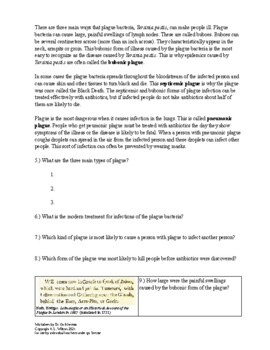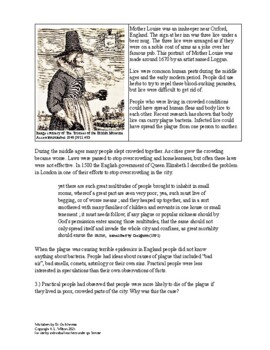- PDF
- Easel Activity
Description
The bacteria that caused the Black Death and other pandemics of bubonic plague can be spread by fleas and human body lice. People can also catch pneumonic plague from other people the same ways people can transmit Covid-19. The Justinian plague and the Black Death were devastating to infected communities. Analysis of DNA from the teeth of neolithic farmers who lived around 5000 years ago has shown that the plague bacteria, Yersinia pestis, had been infecting people for millennia.
Plague Biology
Page 1.) Plague bacteria.
Page 2.) Types of plague infections.
Page 3.) Plague can be spread by blood-sucking insects such as fleas and body lice. Pictures of a flea and pair of lice are included.
Page 4.) Early modern insect vectors of plague.
Includes primary source material about lice and fleas.
This can be left out depending on time available or the age of the students.
It can also be used for enrichment or for early finishers.
Page 5.) Primary source material about mitigation of transmission by fleas and lice.
This can be left out depending on time available or the age of the students.
It can also be used for enrichment or for early finishers.
Historical context
Page 6.) Plague pandemics through the ages.
Neolithic and early bronze age plague DNA extracted from human teeth.
Page 7.) Justinian plague from 542
includes eyewitness descriptions from Procopius
Page 8.) The Black Death
includes an eyewitness account from 1347
Page 9.) Attempts to escape the plague
period woodcut image of bird-beaked plague doctor
Page 10.) Fleeing plague
period woodcut showing people fleeing London in 1665
These worksheets can be used together as one packet or as a few selected pages.
The worksheets can be used to provide very basic scientific background for social studies and history classes exploring the history and effects of the bubonic plague. Plague biology is explored in the context of the historical effects of the bacteria that cause the plague. The facts are presented with no assumption of a serious background in science although background scientific knowledge can enrich understanding of the material.
Selected pages of these worksheets can be used effectively by science teachers to introduce information about uses of DNA testing, bacteria or insect parasites. Historical and human context can increase student interest in the science. Students are especially likely to be interested in the science behind events they are currently studying in their history classes.
DNA testing of ancient teeth from plague burials has given a much more clear understanding of the plague pandemics that have had so much influence on the history of Europe, Asia and Africa. Scientific information in these worksheets was obtained from recent scientific papers although controversial matters were avoided.
The pages on plague history are each part of larger sets of worksheets and activities I plan to upload later. If these worksheets are useful to you you can click on the star next to my owl logo to follow me.
Copyright © 2021 A.L. Wilson
All rights reserved by author.
Permission to copy for classroom use by one teacher only.
Electronic distribution limited to classroom or virtual classroom use by one teacher only.






